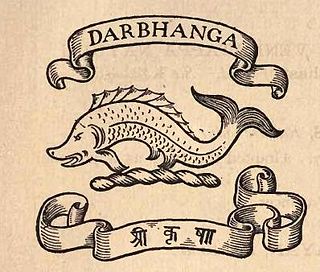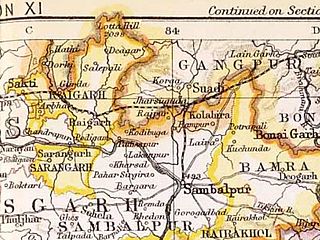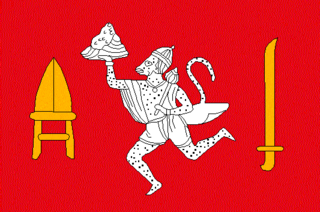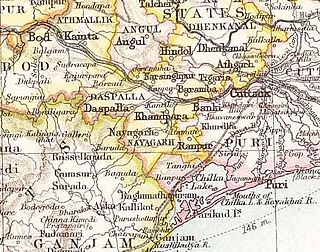Related Research Articles
Ramgarh Raj was the major Zamindari estate in the era of the British Raj in the former Indian province of Bihar. Territories which comprised the Ramgarh Raj presently constitute districts of Ramgarh, Hazaribagh, Chatra, Giridih, Koderma, and Bokaro with 3672 villages. The entire area is rich in minerals like coal and mica and falls under the Indian State of Jharkhand. The First King was Maharaja Baghdeo Singh and the last ruling king was Maharaja Kamakhya Narain Singh of this estate, until the estate was merged to the Republic of India. The revenue of the estate was about 3600000.

The Chand kingdom was a kingdom that ruled the Kumaon area in present-day Uttarakhand state of India, after the decline of the Katyuri kingdom. At times, their rule also extended to the western parts of present-day Nepal. Somchand established the dynasty, establishing his capital at Rajbunga in present-day Champawat.

Rewa State, also known as Rewah, was a kingdom and later princely state of India, surrounding its eponymous capital, the town of Rewa.

The Darbhanga Raj, also known as Raj Darbhanga and the Khandwala dynasty, was a Maithil Brahmin dynasty and the rulers of territories, not all contiguous, that were part of the Mithila region, now divided between India and Nepal. The rulers of Raj Darbhanga were Maithil Brahmins and their seat in the town of Darbhanga became the core of the Mithila region as the rulers were patrons of Maithil culture and the Maithili language.

Bastar state was a princely state in India during the British Raj. It was founded in the early 13th century by Annamaraja, a brother of the last ruler of the Kakatiya dynasty, Prataparudra II.

The Sonbarsa Raj was a medieval chieftaincy and later a zamindari (estate) during British Raj in modern-day Bihar, in erstwhile Bhagalpur district. It was controlled by the Gandhavariya Rajputs.

Jind State was a princely state located in the Punjab and Haryana region of north-western India. The state was 3,260 km2 (1,260 sq mi) in area and its annual income was Rs.3,000,000 in the 1940s. Jind was founded and ruled by Jat Sikh rulers of Sidhu clan.

Sailana State was an 11 gun salute princely state in India, part of the Malwa Agency of Central India during the British Raj. The state enjoyed an estimated revenue of Rs.5,00,000.

Sakti State was one of the princely states of India during the British Raj. It belonged to the Chhattisgarh States Agency, which later became the Eastern States Agency.

Kishangarh State was a Princely State in central Rajputana territory of British India from 1611 to 1948. It was founded by the Jodhpur prince Kishan Singh in the year 1611.He was given the land in and around Kishangarh by Mughal Emperor Jahangir owing to his loyal services as well as a close family relationship.

The Kingdom of Rajgarh also known as Rajgarh State was a princely state in present-day India, named after its capital Rajgarh, Madhya Pradesh. It was part of the colonial Bhopal Agency of the Central India Agency during the British Raj. It lay in the region of Malwa known as Umathwara after the ruling Umath clan of Rajputs, a branch of the Paramara dynasty. The neighbouring Narsinghgarh State was ruled by a cadet branch of this family, after being partitioned in 1681. The Rajgarh State had an area of 2,492 km² and a population of 88,376 in 1901.

Khaniadhana or Khaniyadhana was a princely state of British India ruled by the Judev dynasty of Bundela Rajputs. The capital of the State was Khaniadhana. It was part of the Bundelkhand Agency and later the Central India Agency.

Charkhari State was one of the Princely states of India during the period of the British Raj. On India's independence, this Princely state acceded to India. Currently Charkhari town, the former state's capital, is a part of Uttar Pradesh state.

Udaipur State was one of the princely states of India during the British Raj. The town of Dharamjaigarh was the former state's capital.

Ranpur State was one of many small princely non-salute states of India during the period of the British Raj. It was one of the four native states located in present-day Nayagarh district, Odisha.

Jhabua State was one of the princely states of India during the period of the British Raj. It had its capital in Jhabua town. Most of the territory of the princely state was inhabited by the Bhil people, who constituted a majority of the population. The revenue of the state in 1901 was Rs.1,10,000.

Raghogarh State, also known as Raghugarh and as Khichiwara, was a princely state of the Gwalior Residency, under the Central India Agency of the British Raj. It was a Thikana state of about 109 km2 with 19,446 inhabitants in 1901. The Parbati River marked the western border of the state. The capital was at Raghogarh in the present-day Guna district of Madhya Pradesh.

Namudag is a village and was a erstwhile princely state in the Chhatarpur Block, Palamu district, Jharkhand state, India. It is also known for the Garh of royal family of the Surwar rajput. Namudag princely state consist four zamindari estate Udai garh, Mahuari garh, Naudiha, Gulabjhari which were ruled by the members of the Namudag royal family.

Jhargram Raj was a zamindari which occupied a position in Bengal region of British India. The zamindari came into being during the later part of the 16th century when Man Singh of Amer was the Dewan/Subahdar of Bengal (1594–1606). Their territory was centered around present-day Jhargram district. Jhargram was never an independent territory since the chiefs of the family held it basically as the zamindars of the British Raj in India after Lord Cornwallis's Permanent Settlement of 1793. Although its owners were both rich and powerful, with the chiefs of the family holding the title of Raja, the Jhargram estate was not defined as a Princely State with freedom to decide its future course of action at the time of Indian independence in 1947. Later, the Vice-Roy of India agreed to recognize Jhargram as "Princely State" after the Second World War, but the proposal taken back as the British had decided to give independence to India.

The Dumraon Raj was a feudal principality in the Bhojpur region ruled by the Ujjainiya dynasty. The principality was founded when Raja Horil Singh founded a separate capital for himself in the town of Dumraon. The name Dumraon Raj came from its capital town.
References
- ↑ Journal of Historical Research. Department of History, Ranchi University. 1976. p. 2.
